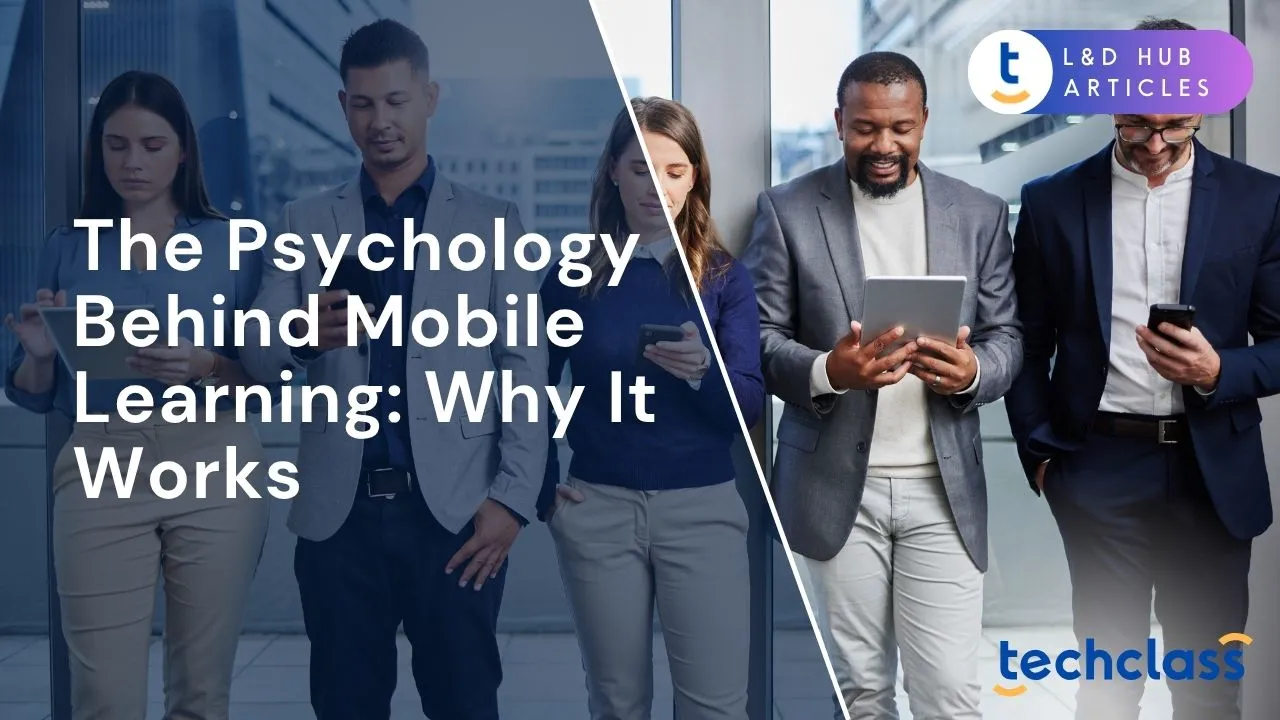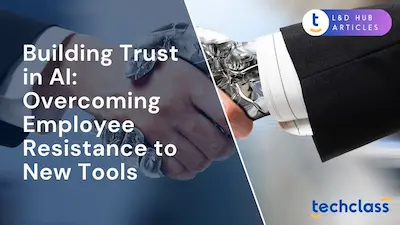
In today’s fast-paced work environment, getting employees to dedicate time to learning is a major challenge. One study found the average employee can spare only about 24 minutes per week for formal training, hardly enough for traditional courses. At the same time, workers crave growth opportunities and will leave companies that don’t provide development. Mobile learning has emerged as a powerful solution to this dilemma. By delivering training through smartphones and tablets, organizations are tapping into how modern employees naturally consume information. The secret behind mobile learning’s success lies in psychology: it aligns with human behavior, cognitive science, and motivational principles. Let’s explore the key psychological reasons mobile learning is so effective for today’s workforce.
Mobile learning capitalizes on the fact that people are almost constantly connected to their devices. Over 80% of the world’s population now uses smartphones, and nearly all millennial workers have one within arm’s reach at any given moment. This means training can happen anytime and anywhere – during a commute, between meetings, or whenever a spare moment arises. The psychological impact of this accessibility is huge. Learning no longer feels like a big, disruptive event that pulls employees away from work. Instead, it becomes a seamless part of their daily routine. Research shows an average user checks their phone over 200 times a day, so delivering learning through that same device significantly reduces barriers to engagement. Busy employees who might skip a lengthy workshop can easily complete a 5-minute lesson on their phone. By meeting learners where they are (on their personal devices) and when they have time, mobile learning leverages convenience to encourage consistent participation. This flexibility also helps normalize continuous learning, it feels natural to pick up new knowledge on the go, just as easily as checking the weather or reading news on a phone. In short, “learning in the palm of your hand” works because it fits into modern life instead of fighting against it.
One of the hallmarks of mobile learning is microlearning, delivering content in bite-sized chunks. This approach is backed by cognitive science. Our brains can only process a limited amount of information at once before memory and attention break down. Mobile learning forces content to be concise and focused, which helps reduce cognitive overload. Lessons are often just a few minutes long, targeting one concept or skill at a time. This aligns with the psychological principle of chunking, where information is broken into manageable pieces that are easier to digest and remember. Moreover, mobile learning platforms frequently use spaced repetition, a proven memory technique. For example, a training app might send a quick quiz or refresher module days after the initial lesson, reinforcing key points over time. Spacing out learning sessions helps transfer knowledge into long-term memory far better than one-off cramming. As Forbes has noted, microlearning leverages spaced repetition to boost retention by continually revisiting material in short bursts. The result is that employees retain more of what they learn. In fact, studies have found that mobile learners can complete courses about 45% faster than desktop learners without sacrificing understanding – and they often remember the information longer. By making learning sessions short, digestible, and repeated over time, mobile learning fits the brain’s natural learning rhythm. These “small bites” add up to a big impact on knowledge retention and comprehension.
Mobile learning isn’t just convenient – it’s also highly engaging, thanks in part to gamification and interactive design. Traditional training methods (like long lectures or dense manuals) often struggle to hold people’s attention. In contrast, mobile learning apps borrow the same techniques that make games and social media so addictive. Many platforms incorporate points, badges, levels, and leaderboards that turn learning into a game-like challenge. This taps into basic human psychology: earning rewards triggers dopamine release in the brain’s reward centers, making the experience enjoyable and motivating learners to keep going. For example, completing a quiz might earn an employee a badge, or finishing a module could move them up on a team leaderboard. These little rewards and competitions spark users’ intrinsic motivation to progress.
Beyond gamification, mobile learning content is typically interactive, think swipeable flashcards, simulation scenarios, or short videos with quizzes. This interactivity keeps the modern learner engaged by requiring active participation rather than passive reading. It also provides instant feedback. Answer a question in a mobile course, and you know right away if you got it right, often with an explanation. Immediate feedback is psychologically powerful because it reinforces correct understanding on the spot (or corrects a mistake before it’s cemented). Additionally, delivering training via smartphone aligns with how younger generations prefer to consume content. Millennials and Gen Z grew up using apps, tapping and swiping through information. Learning that mimics the familiar feel of their favorite apps is inherently more appealing and easier to engage with. Indeed, surveys have found that millennials find it easier to absorb learning delivered on mobile devices versus traditional formats. All these factors, game elements, interactivity, quick feedback, and a familiar app-like experience – combine to make mobile learning highly engaging. When learners enjoy the process, they naturally spend more time on it and absorb more, which is exactly why mobile learning works so well.
Another psychological driver behind mobile learning’s success is the sense of control and personalization it offers to learners. Adult learning theory tells us that adults are self-directed – they learn best when they have a say in what, when, and how they learn. Mobile learning empowers this self-direction. Employees can choose learning modules that are relevant to their needs or interests, and they can complete them at their own pace, on their own schedule. This autonomy is motivating in itself. Instead of being forced into a one-size-fits-all training session at a fixed time, learners on mobile devices decide when they’re ready to learn. Whether it’s early morning or late at night, they have the freedom to engage when their motivation and energy are highest. Psychologically, this respects the learner’s independence and autonomy, which increases intrinsic motivation to participate. In fact, in one study a large majority of employees said they want to identify their own learning needs rather than have a manager dictate them, mobile learning makes that feasible.
Personalization is another key factor. Mobile learning platforms often tailor content to the individual. They might recommend courses based on the user’s role, progress, or past performance, creating a custom learning path. Learners can also usually start, pause, and resume modules as needed, fitting learning into their personal workflow. This personalized approach means each employee can focus on content that feels relevant and skip what doesn’t apply, which enhances the perceived value of the training. When people feel a training is directly useful for their job or goals, they are far more engaged and likely to remember it. Furthermore, learning on one’s own device in a private, self-paced manner can reduce the pressure or embarrassment that sometimes comes with classroom settings. There’s no fear of asking “dumb questions”, you can rewatch a tutorial or retry a quiz without judgment. This creates a safe learning environment that encourages experimentation and practice, which is vital for mastery. Overall, mobile learning works on a psychological level by treating learners as empowered individuals. By providing control, flexibility, and content tailored to their needs, it boosts motivation and makes learning a more positive, user-centric experience.
Mobile learning enables just-in-time learning, delivering knowledge exactly when and where it’s needed. This addresses a critical psychological factor: relevance. People learn best when the material is immediately applicable to a real problem or goal they have. With mobile access, an employee can pull up a quick how-to video or a reference guide on their phone right at the moment they need that information on the job. For example, imagine a technician encountering a new procedure in the field, instead of fumbling or waiting for formal training later, they can watch a 3-minute tutorial on their phone and apply it on the spot. This immediate application of learning reinforces the content in memory (because using knowledge in context helps cement it) and improves performance in real time. It also satisfies the learner’s need to solve a pressing issue, which is highly motivating.
By integrating learning into the flow of work, mobile learning turns training from a separate, abstract activity into a practical support tool. Learners start to see their training as directly tied to solving everyday challenges and advancing their skills when it matters most. This real-time relevance keeps learners attentive – they pay more attention because the answer has direct value right now. Additionally, just-in-time mobile learning contributes to building a continuous learning culture. Employees develop the habit of quickly searching for answers or micro-courses whenever they face something unfamiliar. Over time, this habit means the workforce is constantly upskilling in small ways, rather than waiting for the next scheduled class. The psychological impact is a feeling that learning is always available as a helpful resource rather than a chore. It reduces anxiety about new tasks because employees know they have on-demand support in their pocket. In summary, the “learn now, apply now” nature of mobile learning makes training highly relevant and timely, which dramatically increases its effectiveness and retention.
The psychological advantages of mobile learning, flexibility, microlearning, engagement, autonomy, and relevance, ultimately lead to better learning outcomes and performance. Companies that have embraced mobile learning often report impressive gains. For instance, mobile-based training has been associated with higher knowledge retention rates. In one comparison, learners using mobile platforms were found to retain information significantly longer (one analysis cited up to 58% longer) than those trained in more traditional ways. This makes sense: when learners are engaged, not overwhelmed, and able to review material over time, they remember more. Additionally, motivation and participation tend to increase. Surveys have shown about 70% of learners feel more motivated to learn using a mobile device compared to a computer, and a majority also report greater engagement with mobile learning content. This means employees are not only starting training modules more willingly, but also completing them at higher rates.
From an organizational perspective, these individual improvements translate into real performance benefits. One large company experiment (the Merrill Lynch “GoLearn” initiative) famously found that employees who did training on their mobile devices finished courses roughly 45% faster than those who did the same training on PCs, with no drop in test scores or comprehension. Faster learning cycles get employees up to speed sooner and minimize time away from core job duties. Furthermore, mobile learning can boost productivity. In corporate studies, firms noted around a 40% increase in productivity metrics after implementing mobile learning programs. The convenience of on-demand training means employees spend less time in all-day workshops and more time applying quick learnings directly to their work. Business leaders have observed tangible results like improved sales numbers, better customer service, and fewer errors when employees have continuous learning support via mobile. Embracing mobile learning also contributes to higher employee satisfaction and retention (in the sense of keeping talent). Workers see that their company is investing in modern, convenient development tools, which makes them more likely to stay. In summary, the “why it works” behind mobile learning isn’t just theory, it shows up in metrics like higher knowledge retention, faster training completion, increased engagement, and even positive impacts on the bottom line. These outcomes reinforce that aligning training with human psychology isn’t just a nice idea; it produces measurable benefits for both learners and organizations.
Mobile learning succeeds on a broad scale because it puts learners first. By recognizing and leveraging how people actually behave, learn, and stay motivated, mobile-based training creates an environment where education feels natural and effective. It meets employees in their comfort zone, on their personal devices and on their own time, and uses proven techniques from psychology to keep them interested and improving. For HR professionals and business leaders, understanding the psychology behind mobile learning is key to making the most of it. When designing or selecting mobile learning initiatives, consider the elements discussed above: keep lessons short and focused, make them interactive and rewarding, give learners control and relevant content, and enable learning at the moment of need. By doing so, you ensure the training isn’t just another piece of software, but an engaging growth experience that employees welcome. In an era where continuous upskilling is critical for organizational success, tapping into the psychology of learning can turn training from a checkbox activity into a strategic advantage. Mobile learning, done right, offers that advantage, it aligns modern technology with timeless principles of how we learn best. Harnessing this power will help your workforce stay agile, knowledgeable, and ready to take on new challenges in the ever-evolving world of work.
Mobile learning aligns with human behavior, offers convenience, engagement, and relevance, making training more accessible and effective.
Microlearning delivers concise, focused content that reduces cognitive overload, using spaced repetition to reinforce long-term memory.
Gamification introduces rewards, points, and competitions that boost motivation, engagement, and make learning more enjoyable.
Personalization tailors content to individual needs and preferences, increasing relevance, motivation, and learner autonomy.
It provides immediate access to information at the moment of need, enhancing relevance, performance, and real-time application of skills.


